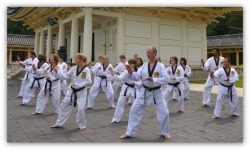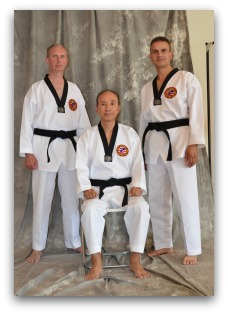 Tae Kwon Do is composed of many components, most dominated
by physical qualities. Front kicks, round kicks, side kicks, hand and aerial
techniques abound, endowing the national Korean martial art with its unique
character. Yet, as the discipline matured from its humble beginnings in the
1940s and 50s, it gained both complexity and academic dimensions until today,
modern educational institutes of higher learning located in Korea offer
Taekwondology, along with its comprehensive syllabus of technique, tradition,
rules and regulations, as a major.
Tae Kwon Do is composed of many components, most dominated
by physical qualities. Front kicks, round kicks, side kicks, hand and aerial
techniques abound, endowing the national Korean martial art with its unique
character. Yet, as the discipline matured from its humble beginnings in the
1940s and 50s, it gained both complexity and academic dimensions until today,
modern educational institutes of higher learning located in Korea offer
Taekwondology, along with its comprehensive syllabus of technique, tradition,
rules and regulations, as a major.
Regardless of the fact that the roots of tae kwon do date
back to antiquity, historians agree that the primordial forms of the art, then known
as kong soo do, tang soo do and for a brief period of time, tae soo do, were
heavily influenced by Okinawan karate-do coupled with Chinese chuan fa,
Japanese judo and, to some degree, aikido and jujutsu. While in transition, ritual
and practice fortifying the burgeoning discipline innocently drew breath from
these styles.
Then, just as the citizenry of the Korean nation were given
the opportunity to reestablish their cultural and technical infrastructure - admittedly
after immeasurable strife and bloodshed - so too did tae kwon do. Rising like a
phoenix from the ashes of war, the disparate styles that were to evolve into a
single, standardized national treasure, took on its own identity within the
pantheon of Asian combat disciplines. Distinctive skills and strategies featuring
philosophical underpinnings exclusive to Korean culture clearly began to emerge
during the latter part of the twentieth century. This process was not easy and
came at great cost, both socially and politically, to many of its founders and
the organizations they would come to create. Yet, today, tae kwon do stands
tall as a battle-proven form of self-defense and a fully recognized Olympic
sport boasting a growth curve second to none; all this is the span of a short
sixty years.
Miracles of this magnitude cannot be accomplished purely on
a physical level. Rather, planning, forethought and the accumulation of knowledge
must be converted into action; action stoked by the uncorrupted transmission of
wisdom across generations. Lessons learned in battle during the Silla (57 BC-AD
935), Koryo (918-1392) and Chosun (1392-1910) dynasties, exemplified by warriors
of the Hwarang and preserved by fighting Buddhist monks called on to defend the
nation against Japanese invaders, are as valid today as they were then. Couple
these tactics with a contemporary understanding of physiology, sports medicine
and body mechanics, and a valid blueprint of academic standards begins to materialize.
The academic approach to tae kwon do becomes abundantly
clear as one sifts through the many editorial contributions offered by scholars,
masters and enlightened practitioners dedicated to the worldwide proliferation
of the art. Through the magic of the Internet, technique, decorum and training
rituals have been exhaustively documented for current and future use. Books,
treatises and dissertations have been written to intellectually support
routines and principles. These, amplified by visual aids, amount to a supreme
body of knowledge that can quite literally take a lifetime to absorb. Great men
and women come to mind who have generously contributed to this paradigm of data
- more than not, at little or no personal gain above that of serving the art. Highly
qualified individuals such as Richard Chun, Sang Kyu Shim, Jane Hallander, Kyong
Myong Lee, Son Duk Sung, Sihak Henry Cho, Stuart Anslow, TaeKwonDo Times columnist Karen Eden and Alex Gillis share this
distinction with others too numerous to mention.
And just what is being documented that justifies tae kwon do
as a discipline worthy of academic pursuit? First and foremost, the technical
catalog that defines the traditional Korean martial art. General Choi Hong Hi,
a primary founder who created the International Taekwon-Do Federation in March
of 1966, claimed an arsenal containing 3200 separate techniques, each with its
own distinct purpose and method of execution, many depicted in his fifteen-volume
Encyclopedia of Taekwon-Do. Similarly,
an updated version of the Kukkiwon
Textbook reissued in 2005 devotes over 700 pages to the proper articulation
of technique. But wisdom accumulated over the decades does not stop there.
Landmark works by Grandmaster Richard Chun and his contemporaries portray
defacto training standards and procedures relied upon worldwide by hundreds of
thousands of students.
Moreover, since tae kwon do is recognized as a comprehensive
form of self-defense with a pedigree reaching far back to the distant past,
there are metaphysical and well as physical concepts to ponder. Exploring the
use of meditation and ki, or internal
energy development, as essential elements of the art demands research that can
only be accomplished through the interrogation of Asian historical and, in some
cases, medical records compiled centuries ago. Valid examples of these are the Yellow Emperor’s Inner Canon, a
cornerstone of Traditional Chinese Medicine, coupled with the physical lessons
posited by the Myue Dobo Tongji
(Illustrated Manual of Korean Martial Arts), authored in 1790.
Then, not to marginalize their significance, if one is to
accrue an absolute understanding of any classical martial art, then it is
equally essential to survey influential native customs, physiological concepts
that power its engine and moral doctrines that govern its use. Many of these
can be found in the teachings of Confucianism, Taoism and Buddhism.
Clearly, taken as a whole the ingredients cited above
compound to represent a body of academic knowledge profoundly worthy of
transmission from one generation to the next. One only need embrace it.
Naturally, as with any established sport, there exists a
majority of practitioners who will exclusively participate for competitive purposes
only. And because tae kwon do offers much in the way of physical fitness and
athletic recognition on the collegiate, state, national and international level,
and because just as a coin, it exhibits two sides, one representing the game
and the other the art, this is entirely understandable. Yet it is important to
recognize the difference between cultivating athletes and holistically-trained
martial artists - practitioners who are not only proficient in the ring, but who
wholeheartedly welcome knowledge concerning the vast mosaic that is traditional
tae kwon do.
 Kamsahamnida to all tour participants, family members, friends and fellow students at home who followed us online! It is not too early to consider making a dream come true in two years by reserving your place on the
Kamsahamnida to all tour participants, family members, friends and fellow students at home who followed us online! It is not too early to consider making a dream come true in two years by reserving your place on the 